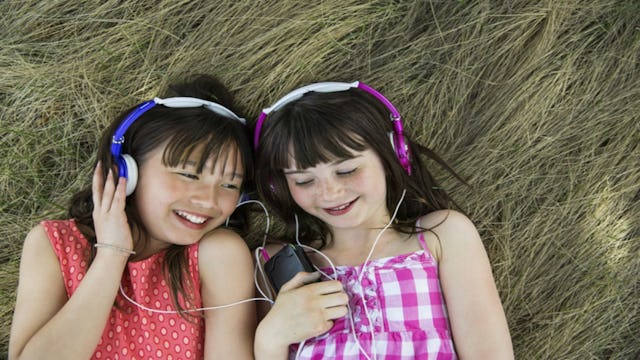Before You Let Your Kids Use Earbuds Or Headphones, Remember This

We see them everywhere we go — in waiting rooms, at parks, zoned out trailing mom in the grocery store, and rocking out in the backseat of minivans. They’re kids with headphones on or ear buds in their ears, and whether they are jamming out to music, watching streaming movies and TV, or playing video games, there’s a great chance they may be damaging their hearing. And in many cases, they may even be contributing to noise-induced hearing loss at a young age.
The use of headphones and earbuds on a daily basis is second nature to this generation of children who appear to be constantly tethered to cell phones, tablets, and video game consoles. But what is all that constant noise in their ears doing to their growing and developing inner ears and hearing?
Well, doctors now believe it’s contributing to early hearing loss, something they’re seeing in teens and millennials at a higher rate than ever before. According to study published in Journal of the American Medical Association, hearing loss is now affecting 20 percent of U.S. adolescents ages 12 to 19, which is a 5 percent increase over the past 15 years. And in a different study, researchers from the American Speech-Language-Hearing Association found that teenagers are listening to devices at a louder volume than adults and that these same teenagers already have symptoms of hearing loss.
Most earbuds and headphones on the market are not specifically engineered with lower decibel levels for children, and therein lies the problem. And if your kids lose earbuds as fast as mine do, then you’re probably like me — buying the cheapest replacements you can find. But it’s those dollar spot and low-end earbuds that don’t come with adjustable volume levels or lower maximum decibel levels, and instead are producing sound well above the recommended listening level of 80 decibels. To add insult to injury, today’s commercial MP3 players typically produce sound at levels around 130 decibels, and earbuds in particular — because of their shape — are, on average, producing sound 7-9 times louder than outside the ear headphones.
Kristina Rigsby, a pediatric audiologist, said listening to devices with levels greater than 80 decibels for long periods of time (which children are commonly doing now) is dangerous, and exposure to high volume “exhausts the auditory system.” She states, “When you are listening to these devices at high levels and for long periods of time, you are putting yourself at risk for hearing loss. And hearing loss is permanent, so once you’ve done the damage, there’s no getting it back.”
The problem has the potential to be so severe, that even the World Health Organization is concerned and has issued a statement and guidelines for safe listening, as well as undertaking awareness campaigns about the dangers of headphones. They warned that 1.1 billion young people are at risk for early hearing loss from personal devices, as well as loud concerts and music festivals.
So what can parents do to turn down the volume so to speak, and prevent early hearing loss?
Well, aside from prohibiting headphone use entirely, there are safer options available — but they’re going to cost you. Look for headphones specifically engineered for children and that offer volume limiting options. If you can afford them, it’s also wise to go with “noise cancelling” headphones that go over and around the entire ear. Because they greatly reduce background noise, noise cancelling headphones reduce the urge to turn up the volume to tune out all those extra sounds.
You can also use Apple’s parental control setting to set lower sound levels on iPhones and iPods, and they will remain locked in place with a password.
Finally, experts recommend that you teach children what proper listening levels are, and to apply what they call the 60/60 rule — which means volumes are kept around 60%, and your kids are listening for a maximum of 60 minutes a day.
The necessity of using headphones is something our children unfortunately cannot avoid. Often, schools even require their use in the classroom — like when students are independently working on tech projects and need to not be disruptive. But taking the necessary precautions, practicing and teaching our kids what healthy listening volumes are, and making an effort to limit their use and/or replace with household personal speakers, can all go a long way in preventing potential early noise induced hearing loss.